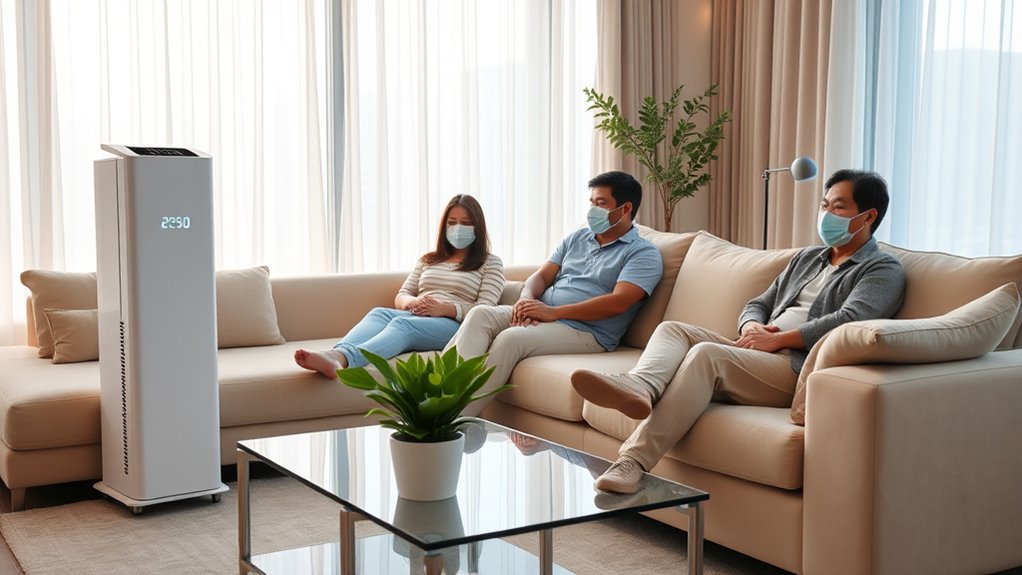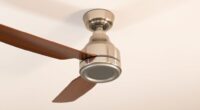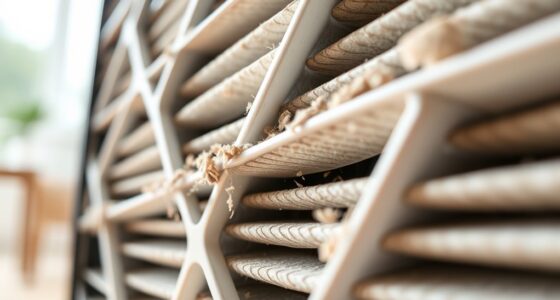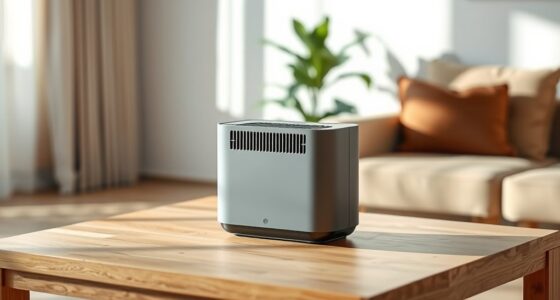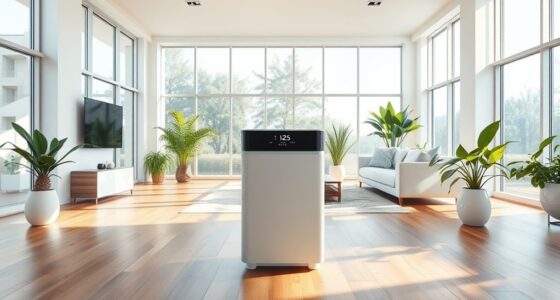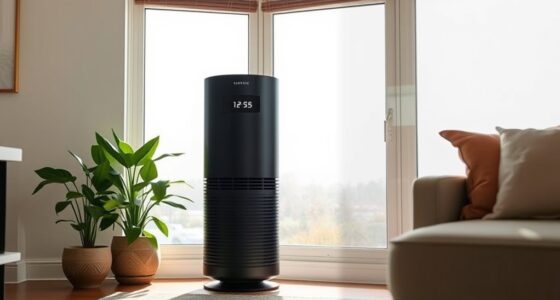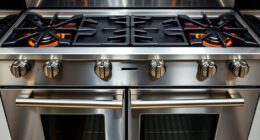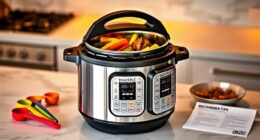Experts say air purifiers can substantially reduce COVID-19 risk indoors by filtering out virus particles and improving air quality. HEPA filters are highly effective at trapping tiny airborne viruses, especially when the purifier is properly placed and used consistently. While they are not a standalone solution, when combined with good ventilation and hygiene, air purifiers add a valuable layer of protection. Keep exploring to discover how to maximize their benefits for your safety.
Key Takeaways
- Experts agree air purifiers with HEPA filters can reduce airborne virus particles indoors.
- Proper placement and continuous operation enhance their effectiveness against COVID-19.
- Air purifiers should complement ventilation, masks, and vaccination, not replace them.
- Regular maintenance and filter replacement are essential for optimal virus filtration.
- They improve overall indoor air quality, providing added health benefits beyond COVID-19 prevention.
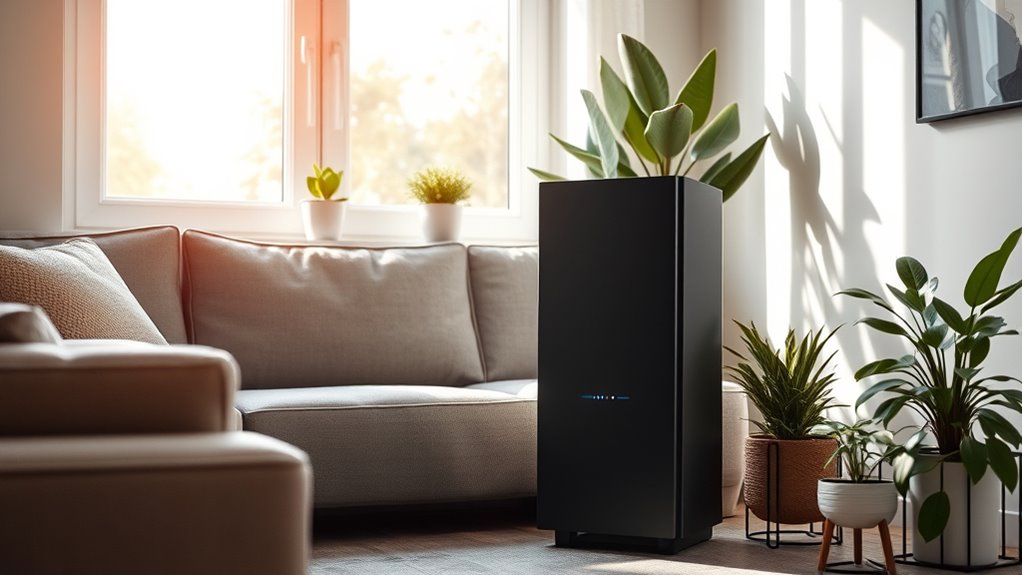
Have air purifiers truly made a difference in reducing COVID-19 transmission? That’s a question many people are asking as they look for ways to protect themselves and their loved ones. The answer isn’t black and white, but experts agree that air purifiers can play a meaningful role in improving indoor air quality and helping to filter out virus particles. When you’re indoors, the air you breathe can accumulate pollutants, allergens, and potentially infectious aerosols. Good indoor air quality isn’t just about comfort; it’s about safety, especially during a pandemic. Air purifiers equipped with HEPA filters are designed to capture tiny particles, including viruses, bacteria, and other airborne contaminants, which are often too small to see but can cause illness.
Air purifiers with HEPA filters help capture virus particles and improve indoor safety during a pandemic.
Virus filtration is a critical feature of effective air purifiers. HEPA filters, in particular, are capable of trapping particles as small as 0.3 microns with 99.97% efficiency. Since the SARS-CoV-2 virus primarily spreads through aerosols that can linger in the air, having a device that can effectively trap these particles reduces the overall viral load in a space. When you use an air purifier properly—placing it in a central location, running it consistently, and maintaining the filter—you create a cleaner environment that minimizes the risk of airborne transmission. It’s important to note that while air purifiers are valuable, they shouldn’t be your only line of defense. Masks, ventilation, and social distancing remain key components of a layered safety plan.
Many studies and expert opinions support the use of air purifiers as part of a layered approach to reducing COVID-19 spread indoors. They can considerably improve indoor air quality by removing not just viruses but also other airborne pollutants like dust, pollen, and pet dander. This can be especially beneficial in crowded or poorly ventilated spaces, such as offices, schools, or shared homes. You’ll want to choose a purifier with a sufficient Clean Air Delivery Rate (CADR) and ensure it’s rated for the size of your room. Proper maintenance, including regular filter replacement, maximizes its virus filtration capabilities. Additionally, incorporating high refresh rates in devices like projectors can enhance overall visual clarity and responsiveness, especially in environments where visual communication is key.
While air purifiers aren’t a foolproof solution, they are a valuable tool in your arsenal for reducing airborne pathogens. They help create a safer indoor environment, giving you peace of mind and reducing the overall risk of COVID-19 transmission. As part of a layered strategy—paired with good hygiene, ventilation, and vaccination—air purifiers can make a real difference in maintaining healthier indoor air quality and, ultimately, protecting your health.
Frequently Asked Questions
Do Air Purifiers Eliminate All Types of COVID-19 Particles?
You might wonder if air purifiers eliminate all COVID-19 viral particles. While they considerably reduce airborne viral particles, they don’t remove everything. The filtration efficiency depends on the device’s filter type, like HEPA filters, which capture most but not all particles. So, while air purifiers help lower the risk, they shouldn’t be your only defense. Combining them with other safety measures remains essential for better protection.
Can Air Purifiers Replace Mask-Wearing During the Pandemic?
You can’t rely solely on air purifiers to replace mask effectiveness during the pandemic. While filtration technology in purifiers can reduce airborne particles, they don’t provide a close, personal barrier like masks do. Masks are essential for blocking respiratory droplets, especially in crowded or indoor settings. Combining mask-wearing with air purifiers offers better protection, but masks remain critical for minimizing COVID-19 transmission.
Are Certain Brands of Air Purifiers More Effective Against COVID-19?
When it comes to effectiveness, you get what you pay for, so don’t judge a book by its cover. Certain brands with a solid reputation often employ advanced filter technology, making their air purifiers more capable of reducing virus particles like COVID-19. Look for units with HEPA filters and reliable reviews, as these features indicate better performance. Choosing wisely means you’re better protected in your space.
How Often Should Air Filters Be Replaced to Ensure Safety?
You should check your air purifier’s filter maintenance guidelines for maximum safety. Typically, replacement frequency varies based on usage and filter type, but most filters need changing every 3 to 6 months. Regularly inspect your filters for dirt and clogging. By adhering to the recommended replacement schedule, you ensure your device works efficiently and continues to improve your indoor air quality.
Do Outdoor Air Purifiers Help Reduce COVID-19 Transmission Indoors?
Did you know that improving outdoor air quality can cut indoor virus transmission risk by up to 50%? Outdoor air purifiers can help, but their virus filtration efficiency varies. They draw in outdoor air, filtering out pollutants and some viruses before it enters your space. While they’re helpful, combining them with good ventilation and air filters offers the best protection against COVID-19 indoors.
Conclusion
While air purifiers can’t turn your home into a fortress, they do serve as vigilant guardians, quietly filtering out invisible threats like tiny shadows dancing in the sunlight. Imagine these devices as gentle sentinels, sweeping away airborne particles and viruses, giving you a puff of fresh confidence. Though they aren’t a sole solution, pairing them with other precautions creates a safer space—allowing you to breathe easier, knowing you’re doing your part to keep the unseen at bay.
